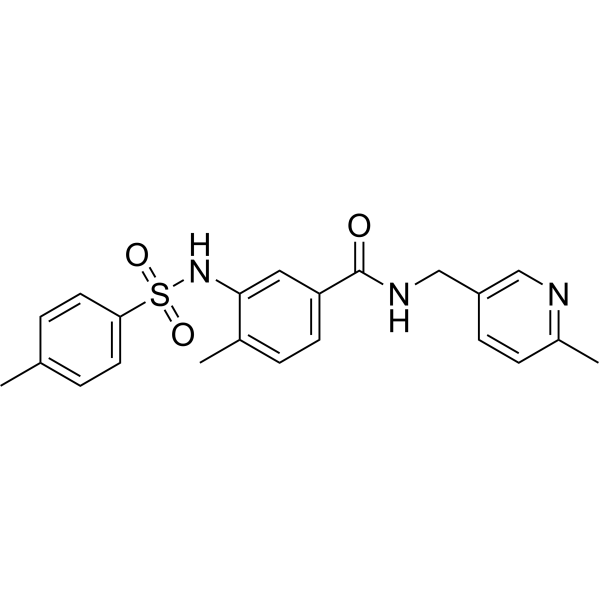Physicochemical Properties
| Molecular Formula | C22H23N3O3S |
| Molecular Weight | 409.50132393837 |
| Exact Mass | 409.146 |
| CAS # | 2366260-33-3 |
| PubChem CID | 139369407 |
| Appearance | Off-white to pink solid powder |
| LogP | 3.3 |
| Hydrogen Bond Donor Count | 2 |
| Hydrogen Bond Acceptor Count | 5 |
| Rotatable Bond Count | 6 |
| Heavy Atom Count | 29 |
| Complexity | 640 |
| Defined Atom Stereocenter Count | 0 |
| SMILES | C(NCC1=CC=C(C)N=C1)(=O)C1=CC=C(C)C(NS(C2=CC=C(C)C=C2)(=O)=O)=C1 |
| InChi Key | ZKRBQBKMMRYJKN-UHFFFAOYSA-N |
| InChi Code | InChI=1S/C22H23N3O3S/c1-15-4-10-20(11-5-15)29(27,28)25-21-12-19(9-6-16(21)2)22(26)24-14-18-8-7-17(3)23-13-18/h4-13,25H,14H2,1-3H3,(H,24,26) |
| Chemical Name | 4-methyl-3-[(4-methylphenyl)sulfonylamino]-N-[(6-methylpyridin-3-yl)methyl]benzamide |
| HS Tariff Code | 2934.99.9001 |
| Storage |
Powder-20°C 3 years 4°C 2 years In solvent -80°C 6 months -20°C 1 month |
| Shipping Condition | Room temperature (This product is stable at ambient temperature for a few days during ordinary shipping and time spent in Customs) |
Biological Activity
| ln Vitro | Tubulin inhibitor 11 (Compound 48) (0.03-0.1 μM; 12 hours), stops the cell cycle at the G2/M phase. In cells, tubulin inhibitor 11 phosphorylates histone H3 at Ser10 while increasing cyclin B1 and decreasing cdc2 phosphorylation[1]. Compound 48 (0.03-0.3 μM; 48 hours) induces apoptosis in cancer cells [1]. With an IC50 of 8 nM, tubulin inhibitor 11 (Compound 48) has good antiproliferative effects in DU145 cells[1]. 48; 0.03-0.3 μM) dramatically and dose-dependently lowers the expression levels of α-tubulin and acetyl-α-tubulin[1]. 11 tubulin inhibitors |
| ln Vivo | Tubulin inhibitor 11 (Compound 48; po; once daily; 5–10 mg/kg) exhibits strong anticancer efficacies in vivo[1]. |
| Cell Assay |
Cell Cycle Analysis[1] Cell Types: DU145 cells Tested Concentrations: 0.01 μM, 0.03 μM, and 0.1 μM Incubation Duration: 12 hrs (hours) Experimental Results: Caused cell cycle arrest at G2/M phase. Apoptosis Analysis[1] Cell Types: DU145 cells Tested Concentrations: 0.03 μM, 0.1 μM, and 0.3 μM Incubation Duration: 48 hrs (hours) Experimental Results: Induced cancer cell apoptosis. Western Blot Analysis[1] Cell Types: DU145 cells Tested Concentrations: 0.01 μM, 0.03 μM, and 0.1 μM Incubation Duration: 12 hrs (hours) Experimental Results: decreased cdc2 phosphorylation and increased cyclin B1 and phosphorylation of histone H3 at Ser10 in cells. |
| Animal Protocol |
Animal/Disease Models: Male athymic BALB/c nude mice (18-20 g) injected with DU145, NCI-H1299 or A549R cells[1] Doses: 5 mg/kg, 10 mg/kg Route of Administration: po; one time/day Experimental Results: Effectively suppressed tumor growth. |
| References |
[1]. Optimization of Benzamide Derivatives as Potent and Orally Active Tubulin Inhibitors Targeting the Colchicine Binding Site. J Med Chem. 2022 Dec 22;65(24):16372-16391. |
Solubility Data
| Solubility (In Vitro) | DMSO : 100 mg/mL (244.20 mM) |
| Solubility (In Vivo) |
Solubility in Formulation 1: ≥ 2.5 mg/mL (6.11 mM) (saturation unknown) in 10% DMSO + 40% PEG300 + 5% Tween80 + 45% Saline (add these co-solvents sequentially from left to right, and one by one), clear solution. For example, if 1 mL of working solution is to be prepared, you can add 100 μL of 25.0 mg/mL clear DMSO stock solution to 400 μL PEG300 and mix evenly; then add 50 μL Tween-80 to the above solution and mix evenly; then add 450 μL normal saline to adjust the volume to 1 mL. Preparation of saline: Dissolve 0.9 g of sodium chloride in 100 mL ddH₂ O to obtain a clear solution. Solubility in Formulation 2: ≥ 2.5 mg/mL (6.11 mM) (saturation unknown) in 10% DMSO + 90% (20% SBE-β-CD in Saline) (add these co-solvents sequentially from left to right, and one by one), clear solution. For example, if 1 mL of working solution is to be prepared, you can add 100 μL of 25.0 mg/mL clear DMSO stock solution to 900 μL of 20% SBE-β-CD physiological saline solution and mix evenly. Preparation of 20% SBE-β-CD in Saline (4°C,1 week): Dissolve 2 g SBE-β-CD in 10 mL saline to obtain a clear solution. Solubility in Formulation 3: ≥ 2.5 mg/mL (6.11 mM) (saturation unknown) in 10% DMSO + 90% Corn Oil (add these co-solvents sequentially from left to right, and one by one), clear solution. For example, if 1 mL of working solution is to be prepared, you can add 100 μL of 25.0 mg/mL clear DMSO stock solution to 900 μL of corn oil and mix evenly. (Please use freshly prepared in vivo formulations for optimal results.) |
| Preparing Stock Solutions | 1 mg | 5 mg | 10 mg | |
| 1 mM | 2.4420 mL | 12.2100 mL | 24.4200 mL | |
| 5 mM | 0.4884 mL | 2.4420 mL | 4.8840 mL | |
| 10 mM | 0.2442 mL | 1.2210 mL | 2.4420 mL |
